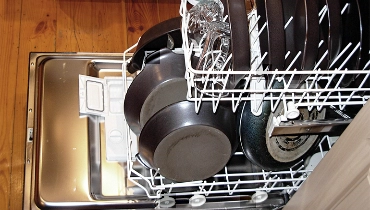
Your dishwasher works hard for you, but sometimes it acts up. If your dishwasher does not drain, several different things could be to blame. While you may end up needing appliance repair, the problem might actually be with the plumbing, not the machine itself. Troubleshoot and fix your dishwasher drainage issues with these tips from Mr. Rooter Plumbing.
Dishwasher Not Draining? Follow these Steps
Before you get started, be aware that it’s normal for some dishwashers to leave a small puddle of water at the bottom of the tub after each cycle. If you see a little bit of water left behind, check the owner’s manual to find out if this is by design.
Note: Never use drain cleaner, dish soap, or inappropriate detergents in a dishwasher.
- Run the garburator: If the kitchen sink isn’t draining well, the dishwasher won’t either. This is because the dishwasher drains into the garburator, so a blockage here affects both the sink and the dishwasher. Make a habit of running the garburator right before every dishwasher cycle to clear the way for water to drain.
- Clear debris from the filter: You’ll find the filter at the bottom of the dishwasher tub under the lower spray arm, or toward the back of the dishwasher. Check if it’s clogged with plastic, paper, glass and bits of food. If so, clear this debris from the filter. If necessary, remove the screws holding the filter cage in place and check inside for more debris.
- Inspect the drain opening where the dishwasher connects to the disposal: If you just installed a new garburator, make sure the plastic plug covering the dishwasher drain opening has been removed. If needed, knock it loose with a screwdriver, and then fish the plug out of the garburator’s grinding chamber.
- Check for a clog in the drain hose: Unplug the dishwasher or turn off the circuit breaker to cut power to the appliance. Remove the toe kick from under the dishwasher door to access the drain hose (it’s usually the one with corrugated ridges). Remove the clamp and disconnect the drain hose from the dishwasher pump. Blow into it to make sure it’s clear. If it’s clogged, remove the clamp from the other end and clean the hose out. You may need to replace the hose if you can’t dislodge the gunk inside.
- Test the valve bracket: Most (but not all) dishwashers have a drain valve that prevents water from flowing back into the appliance. If your dishwasher has a small plastic valve bracket, this means it has a drain valve. While the toe kick is removed from the dishwasher, reach underneath and push on the valve bracket with a pencil or screwdriver to make sure it moves freely. If it’s stuck, this means the electrical solenoid that controls it is burned out and needs to be replaced.
- Check other dishwasher components: If you’ve attempted the above fixes, and your dishwasher still won’t drain, other parts could be at fault, including the check valve, pump solenoid, drain sump, door switch, or electronic control. Testing many of these parts requires a multimeter and knowledge of electrical circuitry. It’s best to leave these types of repairs to the professionals at Mr. Appliance, a Neighbourly company.
Dishwasher Installation & Repair
Mr. Rooter Plumbing provides dishwasher installation and repair along with other kitchen plumbing services. If you’re having problems with your dishwasher not draining, please give us a call today.
Finding you need appliance repair? Contact Mr. Appliance, a Neighbourly company, today.

